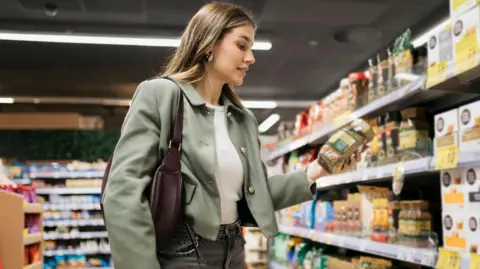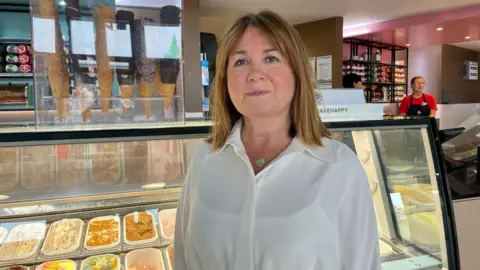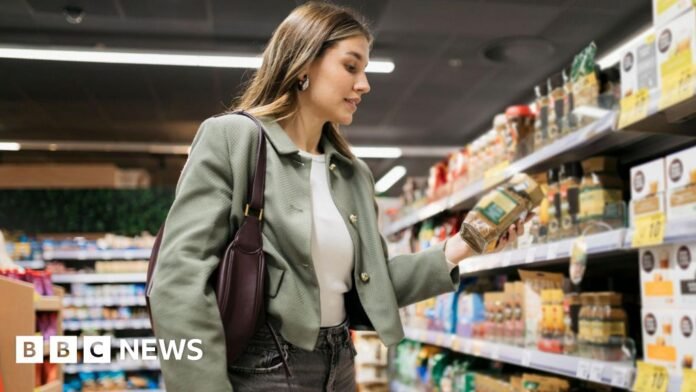Business reporters, BBC News
 Getty Images
Getty ImagesThe cost of everyday food items from instant coffee to beef and fruit juices has continued to rise.
The latest inflation data shows food and non-alcoholic drink prices rose 4.9% in the year to July.
Looking over the longer term, the picture is even more stark.
In the five years to July, food prices increased by around 37%. That compares with a rise of about 5% over the previous five-year period.
So why is this? And are there any signs these price rises in supermarkets, restaurants and cafes could ease soon?
One contributing factor is the climate.
Drought in the UK has meant that crop yields were lower this year, while extreme weather in other countries has raised the wholesale prices of goods like coffee beans and cocoa.
A bad harvest means good crops are “worth more money”, according to one farmer.
Lewis Clare, who produces organic oats and pigs on his 160-acre farm near Manchester, said: “The weather is going to be driving costs up.”
He went on: “I hate to say I think it’s going to go up even more.
“This year has been a problem. It’s been incredibly dry, the crops and yields have been terrible.”
Global events like the war in Ukraine also affect supply chains and push prices up.
Mr Clare said he used to produce eggs but had to remodel his business after Russia invaded Ukraine.
“Whether it’s some kind of extreme weather event or something dramatic like the war in Ukraine, the farmers are the first to feel it, because we are at the frontline, and then it sort of trickles down through to the consumer six to 18 months down the line,” he said.
Business owners have also had to grapple with a rise in the minimum wage, as well as higher employer National Insurance Contributions, which they’ve had to pay since April.
‘Squeezed on all corners’
Jane Matthews, operations director of the Ice Cream Farm in Cheshire, said her business is constantly having to absorb rising costs, from payroll to food to energy.
“We’re being squeezed on all corners,” she told BBC News. But, she added, the company was conscious that “customers’ budgets are also squeezed”.
She said the company felt it had no choice but to pass on these costs to their customers.
“You’ve got to make these decisions now so you can keep going, [otherwise] you might not to be able to employ more people or [have to] close certain things during the year.”
Research published on Tuesday showed that many people are cutting back on fast food and casual dining, replacing it with smaller treats like coffee or a bar of chocolate.
Ms Matthews said she had noticed this through the number of picnics on the farm.
“People might bring a basic picnic and supplement it with a bag of chips for the kids,” she said.
“So we’ve embraced that in the hope that they will still spend here.”
 Elaine Doran
Elaine Doran‘Inflation makes everything more expensive’
For many families, the weekly supermarket shop is the most obvious indicator that the cost of living is still going up, especially when the cost of everyday staples is rising.
Rapid rises in food prices hit low-income families the hardest, according to the Resolution Foundation think tank.
Lalitha Try, an economist at the Resolution Foundation, said that low-income families spend a greater portion of their money on food, so they are more sensitive to price rises at the supermarket.
People and families with a higher income have options if they want to cut back, such as switching to own-brand products, but lower-income households are often already doing that, so there are fewer choices to make, she said.
Danni Hewson, the head of financial analysis at AJ Bell, said consumer trends were also a factor, as demand for high-protein meals had also helped drive up the price of beef.
Even then, households with higher incomes were not immune to rising inflation, she said.
“Most people live to their means, so they may have a car payment, a chunky mortgage, or pay private school fees, and all of those things are what equates to their standard of living they’re used to enjoying,” she said.
“But inflation makes everything more expensive and at some point even people on chunky salaries are having to ask questions about how far their money will stretch and what they might have to give up or change in order to keep the bills in check.”
While the headline inflation figure for food and drink was 4.9%, it is worth remembering that it only shows how much prices have changed over the last year.
The Bank of England expects food price inflation to peak at around 5.5% at the end of the year, before falling to between 2% and 3% in 2026.
Food price inflation is a key driver of overall inflation, and the rate of inflation – particularly when it is too high – affects government policy moves and the Bank’s interest rate decisions.
The autumn Budget is fast approaching and the Bank has three more meetings to decide interest rates this year, so the current rate of inflation – and the next lot of inflation data, due next month – matters.






